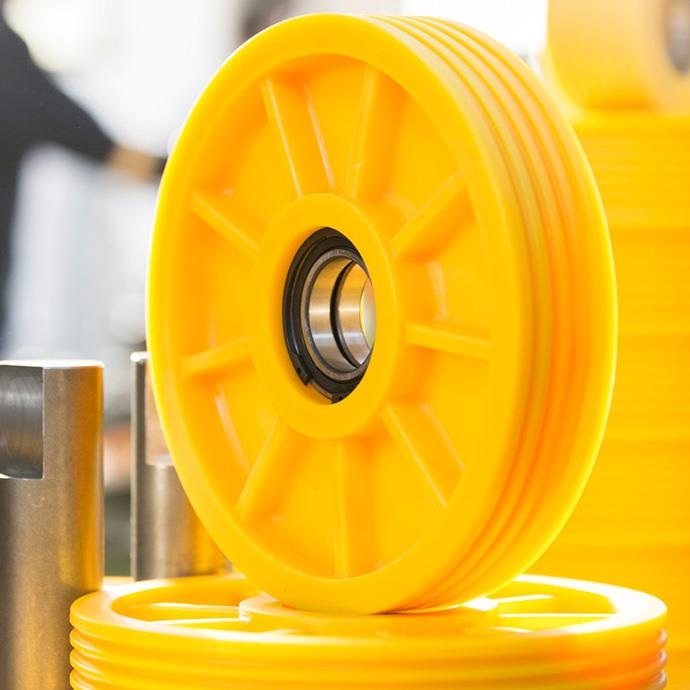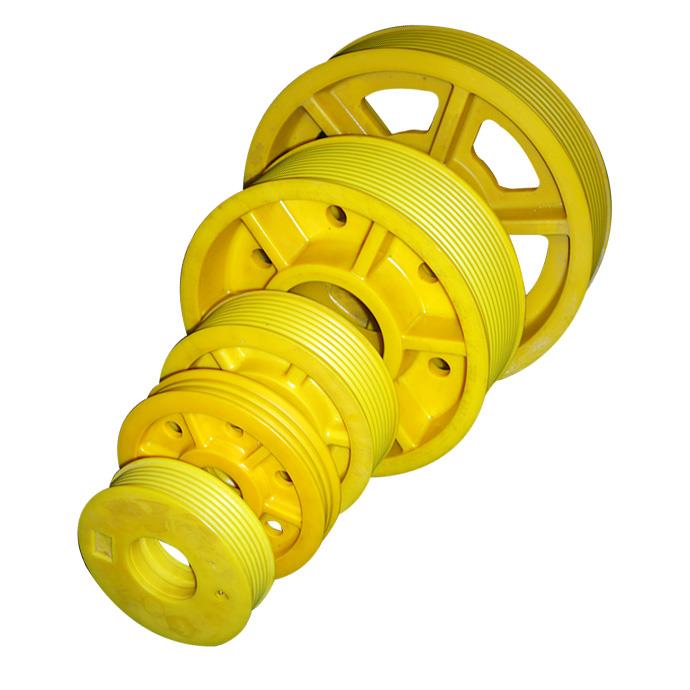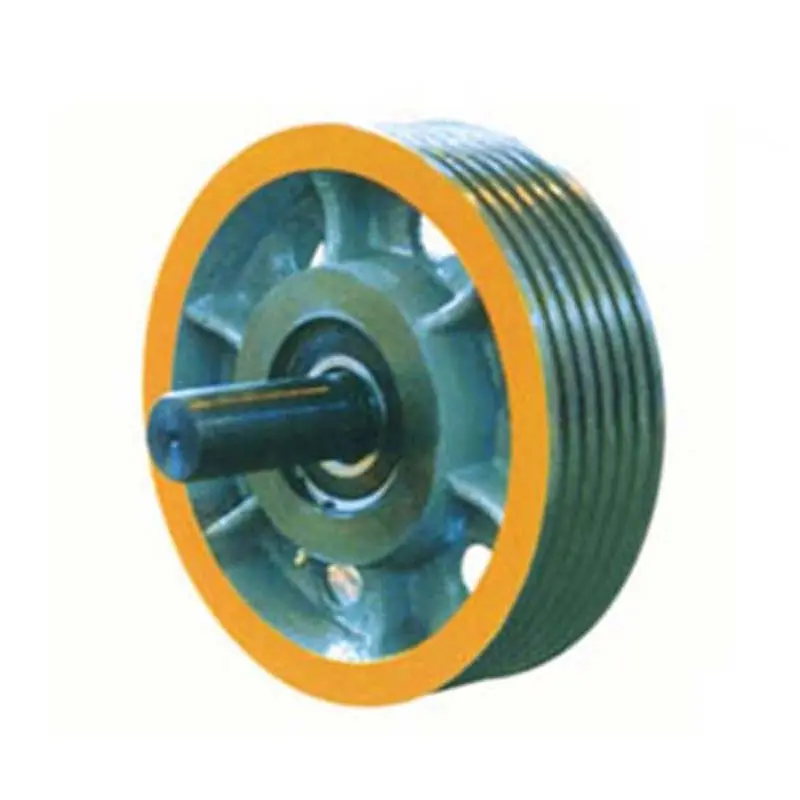Product Description
Specification:
| Product name | Stainless Steel 304 Bearing Pulley U/V Groove for Lifting Sliding Door Track Wheel |
| material | stainless steel |
| bearing | yes |
| color | original |
| Features | customized,low noise,easy installation,sliding smoothly,long life,customized,etc. |
| Application | industrial, door, window, and spare parts for other machines, etc. |
Product Display:
Company Profile:
FAQ:
Q: Are you the manufacturer?
A: Yes, we are a professional manufacturer focused on door and window roller pulleys for over 15 years.
Q: Do you offer free samples?
A: Yes, we are very glad to offer free samples for you to check the quality.
Q: Can we make our own color box?
A: Yes, if the order quantity reaches 1000 sets, we can make a customized color box for you.
Q: Can we print our logo on the products?
A: Yes, we can print your logo on the products according to your design.
Q: How does your factory do regarding quality control?
A: 80% of the staff has 10 years experience, a mature skilled technical team, and a complete quality management system to ensure high quality.
Q: What is the after-sale service for the sliding rollers?
A: We have online technical support. If it is a quality problem, we will replace the broken ones with new ones.
Q: How long is the production time?
A: For samples in stock, shipped in 2 days. if not in stock, the lead time is in 7 days. For mass production, the lead time is around 15 days after receiving the deposit payment.
Q: How about the shipment?
A: For small orders, we can ship them by DHL, FedEx, UPS, TNT, etc. For mass production orders, we can ship them by sea or by air.
/* March 10, 2571 17:59:20 */!function(){function s(e,r){var a,o={};try{e&&e.split(“,”).forEach(function(e,t){e&&(a=e.match(/(.*?):(.*)$/))&&1
| After-sales Service: | Online Support,Free Spare Parts |
|---|---|
| Warranty: | 3 Year |
| Certification: | TUV, CE, ISO |
| Splittable: | Unsplittable |
| Surface Treatment: | Other |
| Material: | Steel |
| Samples: |
US$ 0/Piece
1 Piece(Min.Order) | |
|---|
| Customization: |
Available
| Customized Request |
|---|
How do lifting pulleys contribute to the longevity and reliability of lifting equipment?
Lifting pulleys play a significant role in enhancing the longevity and reliability of lifting equipment. They contribute to the smooth functioning of the lifting system and help minimize wear and tear on various components. Here’s a detailed explanation of how lifting pulleys contribute to the longevity and reliability of lifting equipment:
1. Load Distribution: Lifting pulleys distribute the weight of the load evenly across the lifting system. By spreading the load over multiple ropes or cables, pulleys reduce the strain on individual components, such as cables, hooks, and attachments. This balanced load distribution minimizes the risk of overloading and premature failure of specific parts, thereby prolonging the lifespan of the lifting equipment.
2. Reduced Stress on Components: Lifting pulleys help to alleviate stress on various components of the lifting system. When lifting heavy loads, the force exerted on the cables or ropes can be substantial. By utilizing pulleys, the load is distributed across multiple ropes or cables, reducing the stress on each individual component. This reduction in stress helps prevent excessive stretching, bending, or breakage of cables, ensuring the reliability and longevity of the lifting equipment.
3. Efficient Force Transmission: Lifting pulleys facilitate efficient force transmission within the lifting system. As the load is distributed and redirected through the pulleys, the force is applied in a controlled and balanced manner. This efficient force transmission minimizes unnecessary strain on the lifting equipment and reduces the risk of sudden jerks or jolts that can cause damage or premature wear.
4. Improved Load Control: Lifting pulleys enable precise control over the lifting process, allowing operators to adjust the speed, direction, and position of the load with accuracy. This precise load control helps in preventing sudden or uncontrolled movements that can put stress on the lifting equipment. By ensuring smooth and controlled load handling, pulleys contribute to the longevity and reliability of the lifting equipment.
5. Reduction in Friction: Lifting pulleys are designed to minimize friction between the pulley and the ropes or cables. They often incorporate ball bearings or other low-friction mechanisms to ensure smooth rotation. By reducing friction, pulleys minimize wear on the ropes or cables, as well as on the pulley itself. This reduction in friction helps to extend the lifespan of the lifting equipment.
6. Protection Against Abrasion: Lifting pulleys can incorporate features such as protective coatings or linings to minimize abrasion and wear on the ropes or cables. These protective measures help prevent damage to the lifting equipment caused by repeated rubbing or contact with rough surfaces. By safeguarding against abrasion, pulleys contribute to the longevity and reliability of the lifting equipment.
7. Maintenance and Serviceability: Lifting pulleys are typically designed for easy maintenance and serviceability. They can be quickly inspected, lubricated, and replaced if necessary. Regular maintenance, including cleaning and lubrication of the pulleys, ensures their optimal performance and extends their lifespan. By facilitating routine maintenance, pulleys contribute to the overall reliability and longevity of the lifting equipment.
8. Compatibility and Interchangeability: Lifting pulleys are often designed to be compatible and interchangeable with various lifting systems and configurations. This compatibility allows for easy replacement or upgrading of pulleys as needed. Interchangeability ensures that pulleys can be seamlessly integrated into the existing lifting equipment, thereby extending its reliability and lifespan.
In conclusion, lifting pulleys play a crucial role in promoting the longevity and reliability of lifting equipment. Through load distribution, stress reduction, efficient force transmission, improved load control, friction reduction, protection against abrasion, maintenance and serviceability, as well as compatibility and interchangeability, pulleys contribute to the smooth functioning and extended lifespan of the lifting equipment.
What are some real-world examples of lifting pulley applications in construction projects?
Lifting pulleys are widely used in construction projects for various lifting applications. They enhance the efficiency and safety of lifting heavy loads, equipment, and materials. Here are some real-world examples of lifting pulley applications in construction:
1. Tower Crane Lifting: Tower cranes are commonly employed in construction projects to lift and move heavy materials and equipment vertically and horizontally. These cranes utilize lifting pulleys in their lifting mechanisms. The pulleys distribute the load’s weight, provide mechanical advantage, and enable precise control over the lifting process.
2. Mobile Crane Operations: Mobile cranes, such as truck-mounted or rough-terrain cranes, are versatile lifting equipment used in construction sites. Lifting pulleys are integral components of these cranes, specifically in their boom systems. The pulleys help lift heavy loads and position them accurately, facilitating efficient construction operations.
3. Elevator Installation: In construction projects involving multi-story buildings, elevators are essential for vertical transportation. Lifting pulleys are crucial components in elevator systems. They enable smooth and controlled movement of the elevator car, ensuring safe transportation of passengers or goods between floors.
4. Concrete Pumping: Concrete pumps are used to transport and pour concrete in construction projects. These pumps employ lifting pulleys to lift and position heavy concrete-filled hoses or booms. The pulleys facilitate precise pouring and placement of concrete, allowing for efficient construction processes.
5. Roofing Material Installation: Lifting pulleys are commonly used in construction projects for the installation of roofing materials. They assist in lifting heavy roofing materials, such as shingles or metal panels, to elevated locations. The pulleys help distribute the load’s weight and make it easier for workers to handle and position the roofing materials accurately.
6. Facade Installation: Lifting pulleys play a crucial role in the installation of building facades. They are used to lift and position large panels, glass sheets, or curtain wall components to the desired heights. The pulleys enable controlled movement and precise placement of the facade elements during installation.
7. Bridge Construction: Lifting pulleys are extensively utilized in bridge construction projects. They assist in lifting and positioning heavy bridge components, such as segments, beams, or precast elements. The pulleys distribute the load’s weight and enable precise control over the lifting process, ensuring safe and efficient bridge construction.
These are just a few examples of how lifting pulleys are applied in construction projects. Lifting pulleys offer versatility and adaptability, allowing them to be customized and integrated into various construction lifting systems. By incorporating lifting pulleys, construction projects can benefit from improved lifting capabilities, enhanced efficiency, and safer operations.
How does the design and construction of lifting pulleys impact their lifting capacity?
The design and construction of lifting pulleys have a significant impact on their lifting capacity. Several factors influence how much weight a lifting pulley can handle. Here’s an explanation of how the design and construction of lifting pulleys affect their lifting capacity:
1. Load-Bearing Capacity: The load-bearing capacity of a lifting pulley is determined by its materials and construction. High-strength materials, such as steel or other alloys, are commonly used to ensure the pulley can handle heavy loads without deformation or failure. The pulley’s construction, including the thickness and reinforcement of the wheel, axle, and frame, contributes to its overall load-bearing capacity.
2. Pulley Diameter: The diameter of the lifting pulley affects its lifting capacity. As the diameter increases, the pulley provides a larger surface area for the lifting rope or cable to make contact, distributing the load over a wider area. This distribution of load reduces the stress on the rope or cable, enabling the pulley to lift heavier objects. Larger diameter pulleys generally have higher lifting capacities compared to smaller ones.
3. Number of Sheaves: Lifting pulleys can have single or multiple sheaves or wheels. Pulleys with multiple sheaves, such as double-sheave or triple-sheave pulleys, offer increased mechanical advantage and lifting capacity. Multiple sheaves distribute the load across multiple ropes or cables, reducing the force required to lift the load. The more sheaves a pulley has, the greater its lifting capacity.
4. Bearing System: The bearing system of a lifting pulley affects its smoothness of operation and overall lifting capacity. High-quality bearings, such as ball bearings or roller bearings, reduce friction and enable the pulley to rotate freely. A smooth and efficient bearing system allows the lifting pulley to handle heavier loads with less effort and minimizes wear and tear on the pulley components.
5. Design Efficiency: The design efficiency of a lifting pulley refers to how effectively it converts the input force into lifting force. Well-designed pulleys minimize energy losses due to friction or inefficient pulley geometry. Pulleys with optimized designs, such as those with rounded grooves, reduce the amount of friction between the rope or cable and the pulley, resulting in improved lifting capacity.
6. Safety Factors: Lifting pulleys are often designed with safety factors in mind. Manufacturers consider various safety factors, including the intended application, load requirements, and industry standards, to determine the appropriate lifting capacity for a pulley. The safety factors ensure that the pulley can handle not only the intended load but also account for any unforeseen variations or dynamic loads that may occur during lifting operations.
It’s important to note that the lifting capacity of a pulley is not solely determined by its design and construction. Factors such as the strength of the lifting rope or cable, the condition of the pulley system, and the overall rigging setup also play a role in determining the safe lifting capacity.
In summary, the design and construction of lifting pulleys, including their load-bearing capacity, pulley diameter, number of sheaves, bearing system, design efficiency, and safety factors, all contribute to their lifting capacity. Understanding these factors is crucial for selecting the appropriate lifting pulley for specific lifting applications.
editor by CX
2024-02-01




